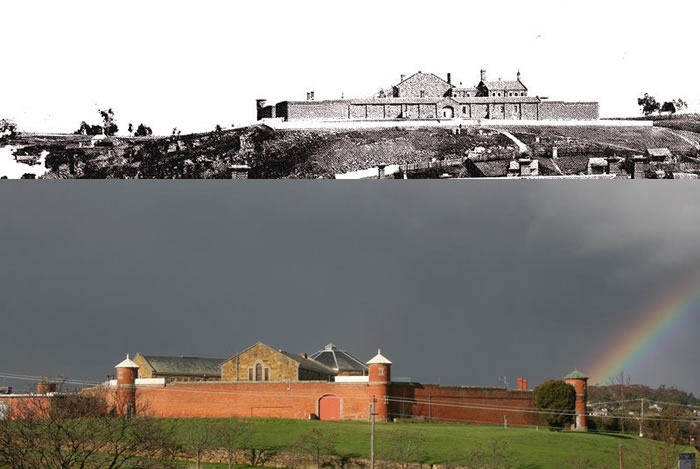Old Castlemaine Gaol |

Looming atop the western horizon in Castlemaine sits a symbol of justice for the Goldfields.
First built in 1861 and active for over 130 years, the Old Castlemaine Gaol has seen men, women and children of all ages pass through its imposing wooden gates, the last prisoners were transferred to HM Prison Loddon in 1990.
The Old Castlemaine Gaol was modelled on Pentonville; the present building replaced the original, designed by Inspector General John Price which was never occupied.
A Brief History
A truly dark historical and cultural space, Old Castlemaine Gaol was built in the 1850-60's while Victoria was experiencing the Gold Rush.
On November 6, 1852 the conception of Castlemaine Gaol was announced. The old log watch house on the government camp, consisting of five extremely cramped cells within appalling conditions, was proclaimed the official "House of Correction". A month later on December 8, Judge Redmond Barry arrived to open the first criminal court in the district. Over 4 days the court heard 40 charges which included such crimes as bush-ranging, burglary, manslaughter, murder, assault, larceny and stealing. A verdict of guilty was found in most cases and criminals were carted off to Castlemaine Gaol.
A few years later a two-storey stone building was constructed on the north-west face of the compound, however this was replaced with new cell blocks as officiated by government processes to improve prisoner conditions across the colony. A wooden palisade was constructed around the property however it was blown over in November 1856. Henry Baker was the contractor who built the separate Warden Quarters at the front of the complex in 1857. Henry was a shonky dealer and was ordered by the Public Works Department to replace materials such as the poor quality of stone supplied by the nearby Bowden Street quarry. The red brick Governors' House and Harcourt granite trimmed walls were constructed by Dalrymple and Simmie who had also worked on Beechworth Gaol.
Daily Life
Life here was cruel and hard labour was the order of the day. Female wrong doers were also imprisoned between 1861 and 1899. Designed on the original Pentonville Gaol in Great Britain, each inmate had their own cell, 4m (13ft.) long, 2m (7ft.) wide and 3 m (9 feet) high with small windows and opening on to narrow landings in the galleries. A central hall with five radiating wings, all visible to staff at the centre, was intended to keep prisoners isolated - the "separate system". Guards had no view into individual cells from their central position; however prisoners were lead to believe they could.
Despite inmates suffering from malnutrition, dehydration, dysentery, pneumonia and other ills and ailments, conditions were considered healthier than other Victorian Gaol's. Whether male or female, each prisoner was expected to do hard labour and menial tasks from six in the morning until seven at night. The food ration was roughly based on the menu served at Pentonville Gaol (GB); that being a breakfast of 10 ounces of bread and three-quarters of a pint of cocoa; dinner was half a pint of soup (or four ounces of meat), five ounces of bread and one pound of potatoes; supper a pint of gruel and five ounces of bread. Visitors of the era noted that the cells were 'admirably ventilated' however 'water closets' were nothing more than communal, evil-smelling recesses.
Cleansing One's Soul
Wearing brown cloth masks, the cell mates were forbidden to speak to each other and were paraded through the exercise yard in silent rows. On their daily visits to the Chapel, they sat in cubicles where they were visible to the warder but hidden from each other. The belief was that with so little contact with others, the law breaker would have time to contemplate their wrong-doings in silent reverence. Basically, it was a daily string of mind games in order to cleanse one's soul.
In reflection, cleansing one's soul must of been of great importance to this entire township. Castlemaine was once a mega-rich gold colony where Catholic, Anglican and Church of England spires stood as phallic symbols of social and religious order towering above the town's skyline even to this day.IMG_1467
Mental Health in a Victorian Era
Fundamentally, if you weren't considered crazy when incarcerated, chances were you would be when or if you left. Mental disturbances were common with numerous cases of insanity, delusion and suicides which went for the most part ignored and untreated.
On 4 January 1860, Captain Bull (a well-liked warden and Chairman of the local Court), laid the foundation stone of the Benevolent Asylum. The Asylum, much like the Gaol, held a commanding position overlooking the township.
The two dominant buildings would have sent a clear message to the townsfolk far and wide - "If you decide to be a law-breaker or step out of the realms of 'normal' in any way - you could either go in this direction, or that". Strange that with every gold town you visit in Victoria, the CHURCH, the GAOL, and the ASYLUM are strongly entrenched.
The Declining Years
In the 1900's the Gaol faced declining numbers, not only in terms of inmate admission but also people considered watching a public hanging as less appealing as attending the midget wrestling fundraiser being held down the road between the Geelong and St. Vincent Orphanages; so the site became a Reformatory School for Boys. The gaol then closed for a number of years, before reopening in 1954 to accommodate medium security prisoners until August 1990.
Current
Save Old Castlemaine Gaol was wound up in 2022.
The gaol has changed hands a number of times.
Currently there are no open times or tours.
❊ Address ❊
⊜ 36-48 Bowden St, Castlemaine 3450 View Map
❊ Web Links ❊
➼ Old Castlemaine Gaol
➼ Save Old Castlemaine Gaol
Disclaimer: Check with the venue (web links) before making plans, travelling or buying tickets.
Accessibility: Contact the venue for accessibility information.
Update Page








